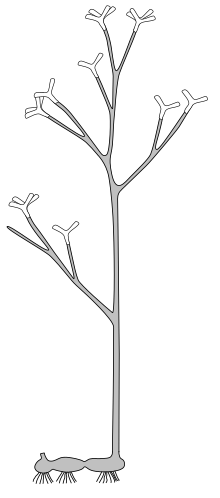Horneophytopsida
| Horneophytopsida Temporal range: Late Silurian to Early Devonian |
|
|---|---|
 |
|
| Reconstruction of Horneophyton lignieri | |
| Scientific classification | |
| Kingdom: | Plantae |
| Division: | †Horneophyta |
| Class: | †Horneophytopsida |
| Synonyms | |
|
|
Horneophytopsida is a class of extinct plants which consisted of branched stems without leaves, true roots or vascular tissue, found from the Late Silurian to the Early Devonian (around 430 to 390 million years ago). They are the simplest known polysporangiophytes, i.e. plants with sporophytes bearing many spore-forming organs (sporangia) on branched stems. They were formerly classified among the rhyniophytes, but it was later found that some of the original members of the group had simple vascular tissue and others did not.
In 2004, Crane et al. published a cladogram for the polysporangiophytes in which the Horneophytopsida are shown as the sister group of all other polysporangiophytes. One other former rhyniophyte, Aglaophyton, is also placed outside the tracheophyte clade, as it did not possess true vascular tissue (in particular did not have tracheids), although its conducting tissue is more complex than that of the Horneophytopsida.
Partial cladogram by Crane, Herendeen & Friis 2004 with emphasis on horneophytes.
(See the Polysporangiophyte article for the expanded cladogram.)
...
Wikipedia
